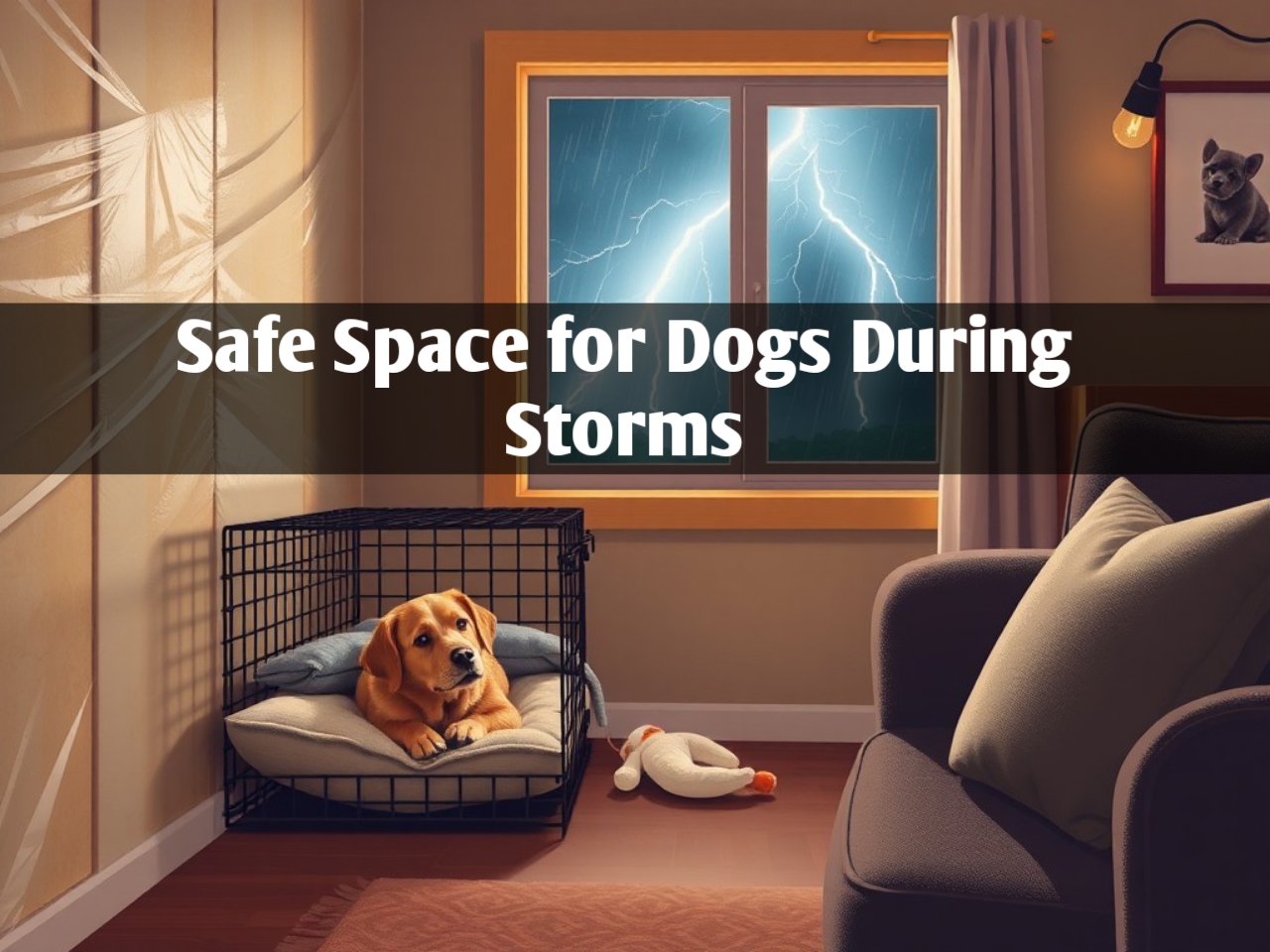Best Ways on How to Protect Walls from Dog During Storm
When a storm strikes, it doesn’t just affect the outdoors—it can also unsettle our beloved pets. For many dog owners, storms can lead to an anxious, restless pet, and in turn, some unwanted behavior inside the home. One of the most common issues is the damage that dogs, in their distressed state, can cause to walls. Claw marks, scratches, and even chewing are all common problems when dogs feel the stress and fear of a storm. Learning how to protect your walls from your dog during a storm is essential to maintaining the look and integrity of your home, and ensuring your dog remains calm and safe. This guide will cover various strategies to safeguard your walls while offering practical advice for dog owners who want to storm-proof their homes.
Understanding Why Dogs React to Storms
Before diving into the solutions, it’s crucial to understand why dogs behave destructively during storms. Thunderstorms are filled with sensory stimuli that dogs are particularly sensitive to—thunder, lightning, and changes in barometric pressure can all trigger anxiety. Some dogs may also sense the storm’s approach through their heightened ability to detect changes in air pressure or static electricity. Once the storm begins, their fight-or-flight response kicks in, and they may scratch at walls, doors, or other parts of the house as they seek to escape or alleviate their anxiety.
This behavior isn’t about disobedience; it’s a natural reaction to stress. Dogs who suffer from storm anxiety often feel trapped inside, unable to run from what they perceive as a threat. Understanding this fear-driven behavior will help you adopt the right strategies to protect your home and, more importantly, help your dog cope with their anxiety in healthier ways.
Preparing Your Home for Storm Season
The first step in protecting your walls from your dog during a storm is preparation. Before storm season arrives, assess the areas in your home where your dog tends to retreat or panic during a storm. These may include corners of rooms, along the baseboards, or behind furniture. Identifying these “problem zones” allows you to focus your efforts on the most vulnerable parts of your home. Consider using washable paint or protective coatings on your walls to minimize damage.
There are several practical ways to storm-proof your home for your dog. Start by moving furniture away from the walls, so your dog has less access to areas they might scratch. Covering the lower part of the walls with protective barriers, such as furniture slipcovers or plastic sheets, can also be effective.
Reinforcing High-Traffic Areas
High-traffic areas, like hallways, doorways, and corners, are especially susceptible to damage during storms. These areas tend to be places where dogs feel cornered or trapped, and they may instinctively scratch or claw at the walls in an attempt to escape. Consider using durable materials like wainscoting, which is not only decorative but also more resistant to wear and tear from dogs. Installing half-wall panels or wall guards made of plastic or rubber is another option to protect your walls.
Alternatively, you can install furniture, such as benches or large planters, along the lower walls to prevent direct access. If your dog tends to scratch at the front door during a storm, consider applying a door guard or kick plate. These metal or plastic plates attach to the lower portion of the door and offer extra protection from dog scratches.
Using Temporary Wall Protection Solutions
In some cases, temporary solutions may be enough to prevent wall damage during a storm. There are several types of protective wall coverings that can be installed quickly and removed when no longer needed. Wall protectors, typically made of clear plastic or heavy-duty vinyl, can be adhered to the lower part of walls. They act as a barrier, preventing your dog from damaging the paint or plaster with their claws. These are especially useful if your dog tends to react to storms in certain rooms or areas.
For a more budget-friendly approach, try using thick cardboard or foam boards as temporary wall shields. You can tape them to the walls or lean them against high-risk areas during the storm and remove them once the weather has passed. While this may not be the most aesthetically pleasing solution, it is an effective one in a pinch and provides excellent protection from claw marks.
Creating a Safe Space for Your Dog
One of the best ways to prevent wall damage during a storm is to provide your dog with a safe, comforting space where they can retreat. Dogs often look for a secure, enclosed area when they are frightened, so creating a designated storm shelter in your home can reduce their anxiety and destructive tendencies. A crate, if your dog is crate-trained, is an ideal option. Make the crate cozy with blankets, a favorite toy, and treats to make it feel like a sanctuary. If your dog isn’t comfortable in a crate, consider using a small room or closet where they can feel secure.
You can also soundproof or semi-soundproof the space using heavy curtains, blankets, or noise-canceling materials to muffle the sound of thunder. Playing calming music or white noise in the room can further help drown out the sounds of the storm and soothe your pet’s nerves. By offering a safe retreat, you reduce the chances of your dog roaming the house in panic and damaging the walls.
Reducing Your Dog’s Anxiety with Behavior Training
Long-term protection for your walls requires addressing the root cause of your dog’s destructive behavior—storm anxiety. There are several behavior training techniques that can help reduce your dog’s anxiety over time. One of the most effective methods is desensitization, which involves gradually exposing your dog to the sounds of a storm in a controlled environment. You can play recordings of thunderstorms at a low volume while rewarding your dog with treats and positive reinforcement. Over time, your dog will begin to associate the sound of storms with something positive rather than frightening.
Another helpful training technique is counterconditioning, which teaches your dog to focus on a specific task or behavior during a storm rather than panicking. For example, you can train your dog to lie down on a mat or go to their crate when they hear the first signs of thunder. By redirecting their attention and rewarding calm behavior, you can help them remain composed during the storm and reduce the likelihood of destructive actions like wall scratching.
Using Calming Products for Storm Anxiety
In addition to behavior training, there are a variety of calming products that can help soothe your dog during a storm, reducing their stress and preventing them from damaging your walls. Anxiety wraps, like the popular Thundershirt, apply gentle pressure to your dog’s body, which has a calming effect similar to swaddling a baby. These wraps can be very effective for dogs who experience mild to moderate storm anxiety.
Another option is using calming sprays or diffusers, which release natural pheromones that mimic the scent a mother dog produces to comfort her puppies. These products, such as Adaptil, can help reduce your dog’s anxiety during a storm and prevent destructive behavior. Additionally, there are calming treats or supplements made with ingredients like chamomile, valerian root, and L-theanine, which can help take the edge off your dog’s anxiety without making them too drowsy.
Protecting Your Home with Pet-Friendly Furniture and Materials
Another key element in preventing wall damage from your dog during a storm is to invest in pet-friendly furniture and materials. Consider using more durable, scratch-resistant paint on your walls, such as semi-gloss or satin finishes, which are easier to clean and less likely to show marks. For baseboards and door frames, opt for materials like PVC or other synthetic alternatives that are more resistant to scratches and bites than wood.
When choosing furniture, look for pet-friendly fabrics like microfiber, leather, or outdoor-grade materials that are easy to clean and hold up well against scratching. You can also use washable slipcovers on your furniture to make cleaning up after a stormy day easier. Incorporating these materials into your home will not only help protect against storm-related anxiety but also prolong the lifespan of your interior décor.
Managing Storm Anxiety with Veterinarian Help
If your dog’s storm anxiety is severe and leads to destructive behavior, such as repeatedly damaging walls or harming themselves, it may be time to consult with a veterinarian. In some cases, anxiety medications may be necessary to help your dog cope with storms. Anti-anxiety medications or sedatives prescribed by a veterinarian can provide short-term relief during storm season, especially if behavior modification and calming products are not enough.
Veterinarians can also recommend other interventions, such as prescription calming diets or more intensive behavioral therapies. It’s essential to address storm anxiety early, as untreated anxiety can worsen over time, leading to more significant behavioral issues and increased damage to your home.
Conclusion: Long-Term Solutions for Protecting Your Walls and Your Dog
Protecting your walls from dog damage during a storm involves a combination of preventative measures, training, and care for your dog’s emotional well-being. By understanding why dogs react to storms the way they do, preparing your home, and using a variety of tools like temporary wall protectors, behavior training, and calming products, you can minimize the damage to your home and create a more comfortable environment for your pet. Addressing your dog’s storm anxiety with veterinarian support, if necessary, can also be crucial in protecting your home long-term.
Ultimately, the goal is to help your dog feel safer and more secure during storms so that their fear doesn’t manifest in destructive behavior. With these strategies in place, you can weather the storm season while keeping both your home and your dog safe from harm.
Read Also Our This Post: Brian Harmon UX Designer: Creating User-Centered Digital Solutions

Kamran Khatri is a versatile writer and editor at ExpressZone.co.uk, bringing fresh perspectives and insightful commentary across a wide range of topics. With a passion for exploring diverse subjects—from technology, business, and finance to lifestyle, travel, and the arts—Kamran aims to inform, inspire, and engage readers through well-researched articles and thought-provoking content.
His work spans multiple categories including health, education, pets, entertainment, real estate, and sustainability, reflecting his commitment to delivering knowledge that connects with everyday life. Whether breaking down the latest trends, sharing practical tips, or highlighting cultural insights, Kamran’s writing combines clarity with creativity.
When he’s not crafting stories for ExpressZone.co.uk, Kamran enjoys keeping up with global developments, exploring innovative ideas, and connecting with readers who share his curiosity about the world.







